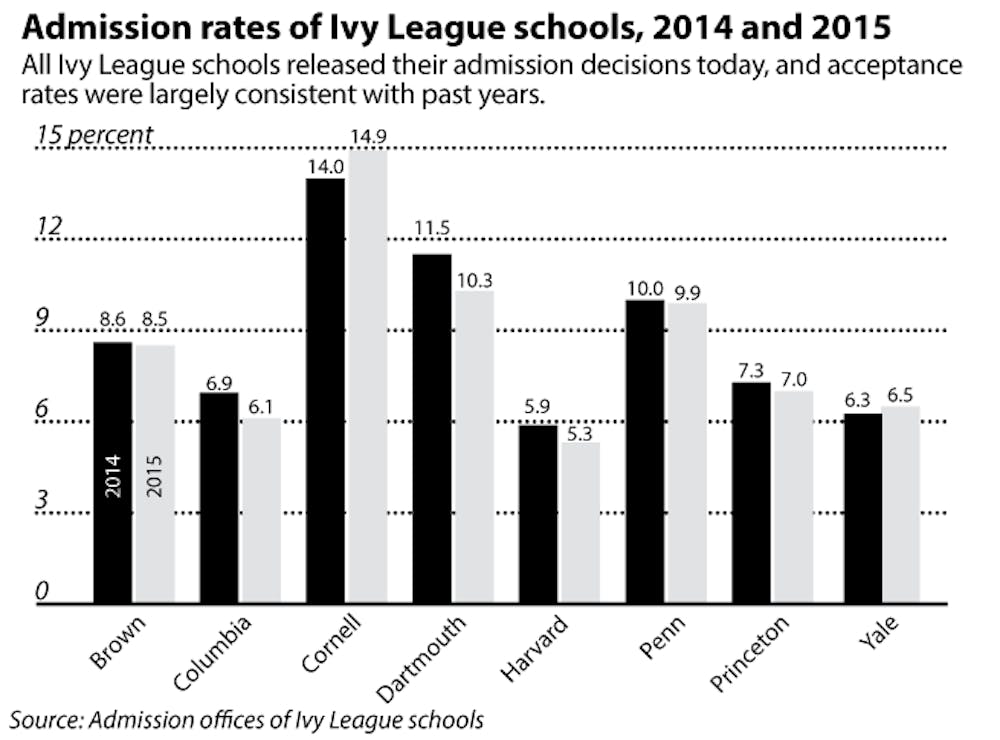The University offered admission to just under 8.5 percent of applicants to the class of 2019, breaking last year’s record-low acceptance rate of 8.6 percent, said Dean of Admission Jim Miller ’73.
Out of the 30,397 students who applied — the second largest pool in University history — 2,580 students were admitted. The 1,970 students accepted through the regular decision process will join over 600 students admitted in December.
The percentage of first-generation college students admitted decreased from 18 percent last year to 13 percent this year, Miller said.
Sixty-one percent of admits intend to apply for financial aid — slightly down from last year’s 67 percent, he said.
Admitted students hail from all 50 states and 85 countries, according to a University press release. Among domestic admits, the best-represented states are California, New York, Massachusetts, New Jersey and Texas. Among international admits, the top five countries represented are China, the United Kingdom, Canada, India and Korea.
The diversity of the admitted class of 2019 is fairly consistent with that in the past few admission cycles, Miller said. Forty-five percent of admits self-identify as African American, Latino, Native American or Asian American.
Fifty-nine percent of admits attend public high schools, while 41 percent attend either private or parochial schools.
Though the pool of accepted students is similar in many ways to the pools of previous years, this year saw a shift in intended concentrations. Though seven of the top nine intended concentrations — engineering, biology, computer science, biochemistry, international relations, economics and political science — were holdovers from last year, history and English also joined the list. Interest in concentrating in history increased by about 80 percent since last year, according to the press release.
Over the last decade, there has been a gradual increase in students pursuing sciences, causing the number of students pursuing the humanities to drop, Miller said. This trend may result from the fact that the American economic climate has made students focus more on the practicality of their degrees. But this year’s increased interest in history and English “hopefully suggests a greater interest in liberal arts generally,” he added.
Brown’s special admission programs saw even lower admission rates. The Brown-RISD Dual Degree Program accepted just 3 percent of 512 applicants. The Program in Liberal Medical Education admitted 90 of 2,216 students, marking a 4 percent acceptance rate, Miller said. These two programs are “widely competitive with an acceptance rate consistently in the low single digits,” he added.
It is hard to predict how many students will accept positions on the waitlist, Miller said. “We do anticipate to take some students off the waitlist this year,” he said.
The other Ivy League universities also released their admission decisions Tuesday. Their admission rates were fairly consistent with those in previous years — Columbia accepted 6.1 percent, Cornell accepted 14.9 percent, Dartmouth accepted 10.3 percent, Harvard accepted 5.3 percent, Princeton accepted 7 percent, Penn accepted 9.9 percent and Yale accepted 6.5 percent.
Many admitted students expressed surprise and excitement about their offers of admission.
“I fully expected rejection,” said Scott Fogle, who hails from Pennsylvania and is currently taking a gap year in San Francisco. Fogle said he hopes to visit the University this month before making his final decision.
Ann Tanaka from California said she tried not to become too attached to any one school before getting accepted. “I’ve seen qualified people get rejected and surprising ones get admitted,” Tanaka said.
All admitted students are invited to visit the University during A Day on College Hill, which will occur April 21- 23. “ADOCH is the University’s most important recruitment program,” Miller said, adding that the University expects about 800 admitted students and 500 parents to come to campus for the event.





